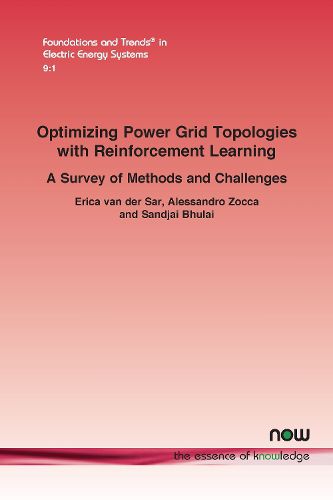Readings Newsletter
Become a Readings Member to make your shopping experience even easier.
Sign in or sign up for free!
You’re not far away from qualifying for FREE standard shipping within Australia
You’ve qualified for FREE standard shipping within Australia
The cart is loading…






This title is printed to order. This book may have been self-published. If so, we cannot guarantee the quality of the content. In the main most books will have gone through the editing process however some may not. We therefore suggest that you be aware of this before ordering this book. If in doubt check either the author or publisher’s details as we are unable to accept any returns unless they are faulty. Please contact us if you have any questions.
Electrical power grids form the backbone of modern society, being responsible for transporting electricity from producers to consumers 24 hours a day, 365 days a year. Operating these grids is a demanding control task that requires continuous monitoring and frequent interventions by skilled experts to maintain network stability, keep power flow within the thermal limits of the equipment, and ensure voltage and frequency levels are met.
Power grid operation is becoming increasingly complex due to the rising integration of renewable energy sources and the need for more adaptive control strategies. Reinforcement Learning (RL) has emerged as a promising approach to power network control, offering the potential to enhance decision-making in dynamic and uncertain environments. The Learning To Run a Power Network (L2RPN) competitions have played a key role in accelerating research by providing standardized benchmarks and problem formulations, leading to rapid advancements in RL-based methods.
This monograph provides a comprehensive and structured overview of RL applications for power grid topology optimization, categorizing existing techniques, highlighting key design choices, and identifying gaps in current research. Additionally, a comparative numerical study evaluating the impact of commonly applied RL-based methods is presented, offering insights into their practical effectiveness. By consolidating existing research and outlining open challenges, this work aims to provide a foundation for future advancements in RL-driven power grid optimization.
$9.00 standard shipping within Australia
FREE standard shipping within Australia for orders over $100.00
Express & International shipping calculated at checkout
This title is printed to order. This book may have been self-published. If so, we cannot guarantee the quality of the content. In the main most books will have gone through the editing process however some may not. We therefore suggest that you be aware of this before ordering this book. If in doubt check either the author or publisher’s details as we are unable to accept any returns unless they are faulty. Please contact us if you have any questions.
Electrical power grids form the backbone of modern society, being responsible for transporting electricity from producers to consumers 24 hours a day, 365 days a year. Operating these grids is a demanding control task that requires continuous monitoring and frequent interventions by skilled experts to maintain network stability, keep power flow within the thermal limits of the equipment, and ensure voltage and frequency levels are met.
Power grid operation is becoming increasingly complex due to the rising integration of renewable energy sources and the need for more adaptive control strategies. Reinforcement Learning (RL) has emerged as a promising approach to power network control, offering the potential to enhance decision-making in dynamic and uncertain environments. The Learning To Run a Power Network (L2RPN) competitions have played a key role in accelerating research by providing standardized benchmarks and problem formulations, leading to rapid advancements in RL-based methods.
This monograph provides a comprehensive and structured overview of RL applications for power grid topology optimization, categorizing existing techniques, highlighting key design choices, and identifying gaps in current research. Additionally, a comparative numerical study evaluating the impact of commonly applied RL-based methods is presented, offering insights into their practical effectiveness. By consolidating existing research and outlining open challenges, this work aims to provide a foundation for future advancements in RL-driven power grid optimization.